Taxation Law: Capital Gains, Fringe Benefits, and Property
VerifiedAdded on 2020/04/01
|9
|1815
|35
Report
AI Summary
This report provides an analysis of several key areas within Australian taxation law. It begins by addressing the determination of net capital gains or losses, examining the application of the Income Tax Assessment Act 1997 to various assets, including collectables, personal use assets, and business assets. The report then delves into fringe benefit tax (FBT), specifically concerning loans provided by employers to employees at below-market interest rates, calculating the taxable value of the fringe benefit. Furthermore, the report explores the taxation of jointly owned rental properties, analyzing how profits and losses are distributed among co-owners, referencing relevant taxation rulings and case law. It also touches upon the principle of tax avoidance as established in IRC v Duke of Westminster. Finally, the report examines the tax implications of selling felled timber from a land owner's property, determining whether the proceeds constitute taxable income under primary production rules. The analysis incorporates relevant sections of the Income Tax Assessment Act and relevant taxation rulings, providing a comprehensive overview of the topics covered.
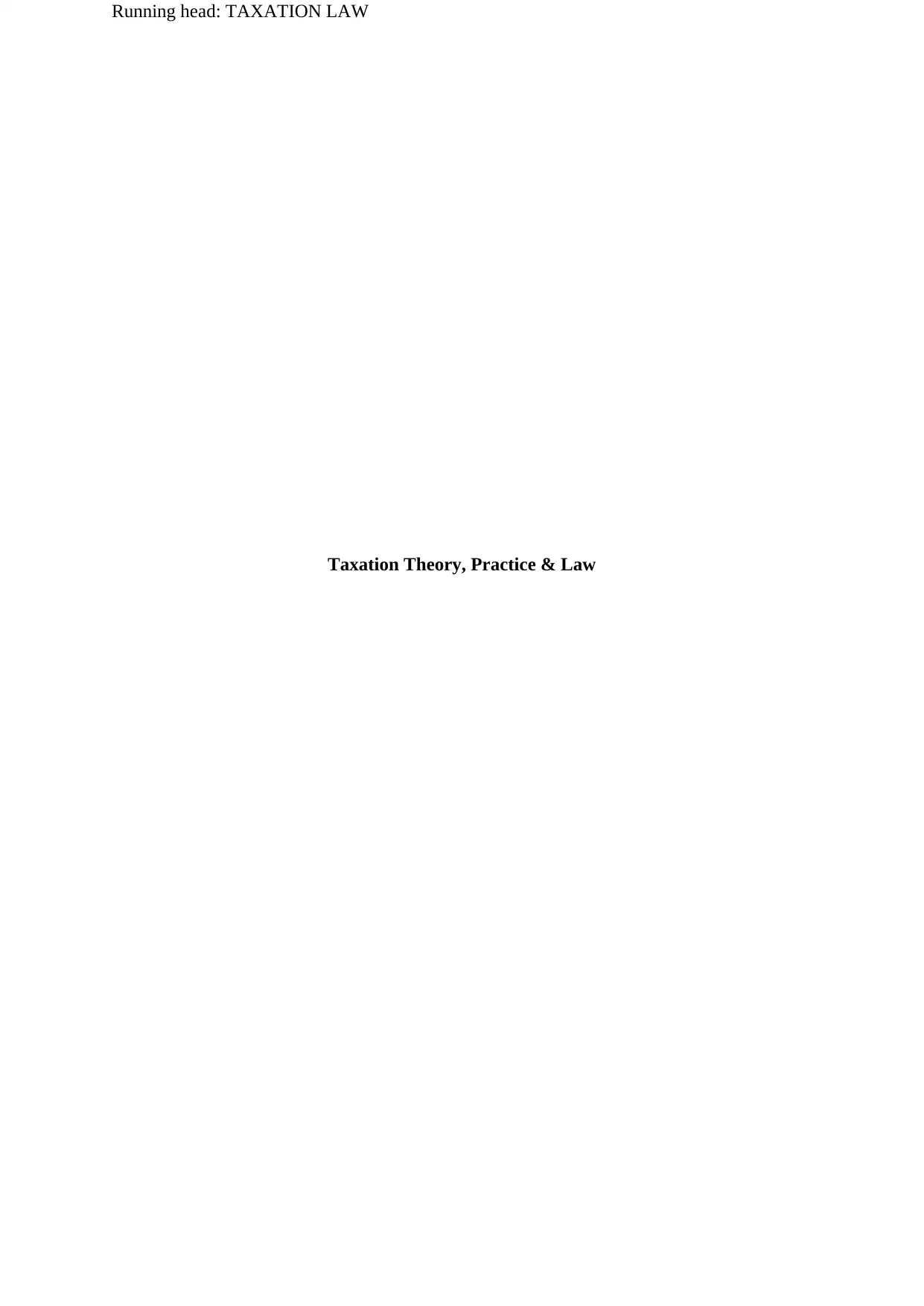
Running head: TAXATION LAW
Taxation Theory, Practice & Law
Taxation Theory, Practice & Law
Paraphrase This Document
Need a fresh take? Get an instant paraphrase of this document with our AI Paraphraser
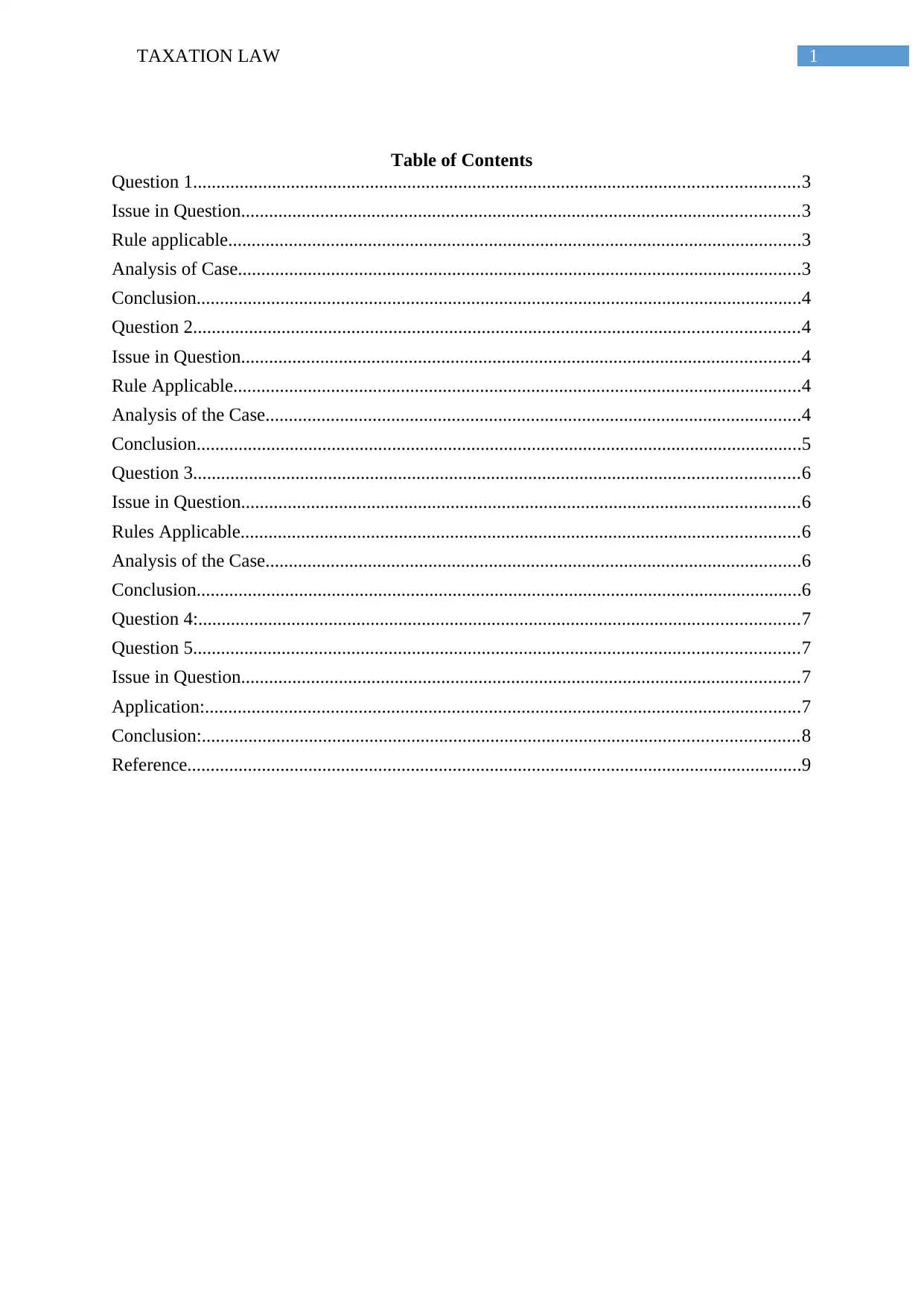
1TAXATION LAW
Table of Contents
Question 1..................................................................................................................................3
Issue in Question........................................................................................................................3
Rule applicable...........................................................................................................................3
Analysis of Case.........................................................................................................................3
Conclusion..................................................................................................................................4
Question 2..................................................................................................................................4
Issue in Question........................................................................................................................4
Rule Applicable..........................................................................................................................4
Analysis of the Case...................................................................................................................4
Conclusion..................................................................................................................................5
Question 3..................................................................................................................................6
Issue in Question........................................................................................................................6
Rules Applicable........................................................................................................................6
Analysis of the Case...................................................................................................................6
Conclusion..................................................................................................................................6
Question 4:.................................................................................................................................7
Question 5..................................................................................................................................7
Issue in Question........................................................................................................................7
Application:................................................................................................................................7
Conclusion:................................................................................................................................8
Reference....................................................................................................................................9
Table of Contents
Question 1..................................................................................................................................3
Issue in Question........................................................................................................................3
Rule applicable...........................................................................................................................3
Analysis of Case.........................................................................................................................3
Conclusion..................................................................................................................................4
Question 2..................................................................................................................................4
Issue in Question........................................................................................................................4
Rule Applicable..........................................................................................................................4
Analysis of the Case...................................................................................................................4
Conclusion..................................................................................................................................5
Question 3..................................................................................................................................6
Issue in Question........................................................................................................................6
Rules Applicable........................................................................................................................6
Analysis of the Case...................................................................................................................6
Conclusion..................................................................................................................................6
Question 4:.................................................................................................................................7
Question 5..................................................................................................................................7
Issue in Question........................................................................................................................7
Application:................................................................................................................................7
Conclusion:................................................................................................................................8
Reference....................................................................................................................................9
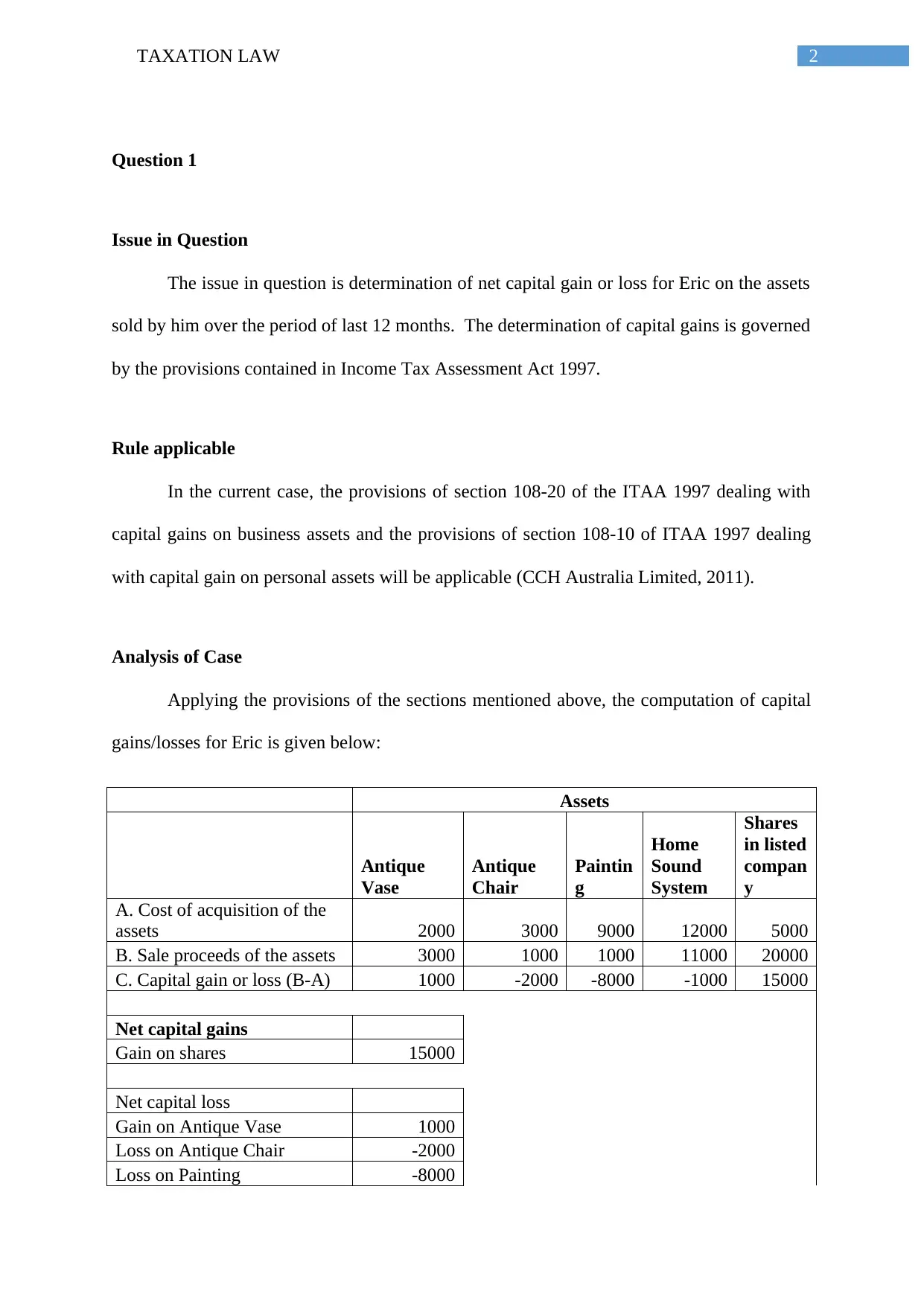
2TAXATION LAW
Question 1
Issue in Question
The issue in question is determination of net capital gain or loss for Eric on the assets
sold by him over the period of last 12 months. The determination of capital gains is governed
by the provisions contained in Income Tax Assessment Act 1997.
Rule applicable
In the current case, the provisions of section 108-20 of the ITAA 1997 dealing with
capital gains on business assets and the provisions of section 108-10 of ITAA 1997 dealing
with capital gain on personal assets will be applicable (CCH Australia Limited, 2011).
Analysis of Case
Applying the provisions of the sections mentioned above, the computation of capital
gains/losses for Eric is given below:
Assets
Antique
Vase
Antique
Chair
Paintin
g
Home
Sound
System
Shares
in listed
compan
y
A. Cost of acquisition of the
assets 2000 3000 9000 12000 5000
B. Sale proceeds of the assets 3000 1000 1000 11000 20000
C. Capital gain or loss (B-A) 1000 -2000 -8000 -1000 15000
Net capital gains
Gain on shares 15000
Net capital loss
Gain on Antique Vase 1000
Loss on Antique Chair -2000
Loss on Painting -8000
Question 1
Issue in Question
The issue in question is determination of net capital gain or loss for Eric on the assets
sold by him over the period of last 12 months. The determination of capital gains is governed
by the provisions contained in Income Tax Assessment Act 1997.
Rule applicable
In the current case, the provisions of section 108-20 of the ITAA 1997 dealing with
capital gains on business assets and the provisions of section 108-10 of ITAA 1997 dealing
with capital gain on personal assets will be applicable (CCH Australia Limited, 2011).
Analysis of Case
Applying the provisions of the sections mentioned above, the computation of capital
gains/losses for Eric is given below:
Assets
Antique
Vase
Antique
Chair
Paintin
g
Home
Sound
System
Shares
in listed
compan
y
A. Cost of acquisition of the
assets 2000 3000 9000 12000 5000
B. Sale proceeds of the assets 3000 1000 1000 11000 20000
C. Capital gain or loss (B-A) 1000 -2000 -8000 -1000 15000
Net capital gains
Gain on shares 15000
Net capital loss
Gain on Antique Vase 1000
Loss on Antique Chair -2000
Loss on Painting -8000
⊘ This is a preview!⊘
Do you want full access?
Subscribe today to unlock all pages.

Trusted by 1+ million students worldwide
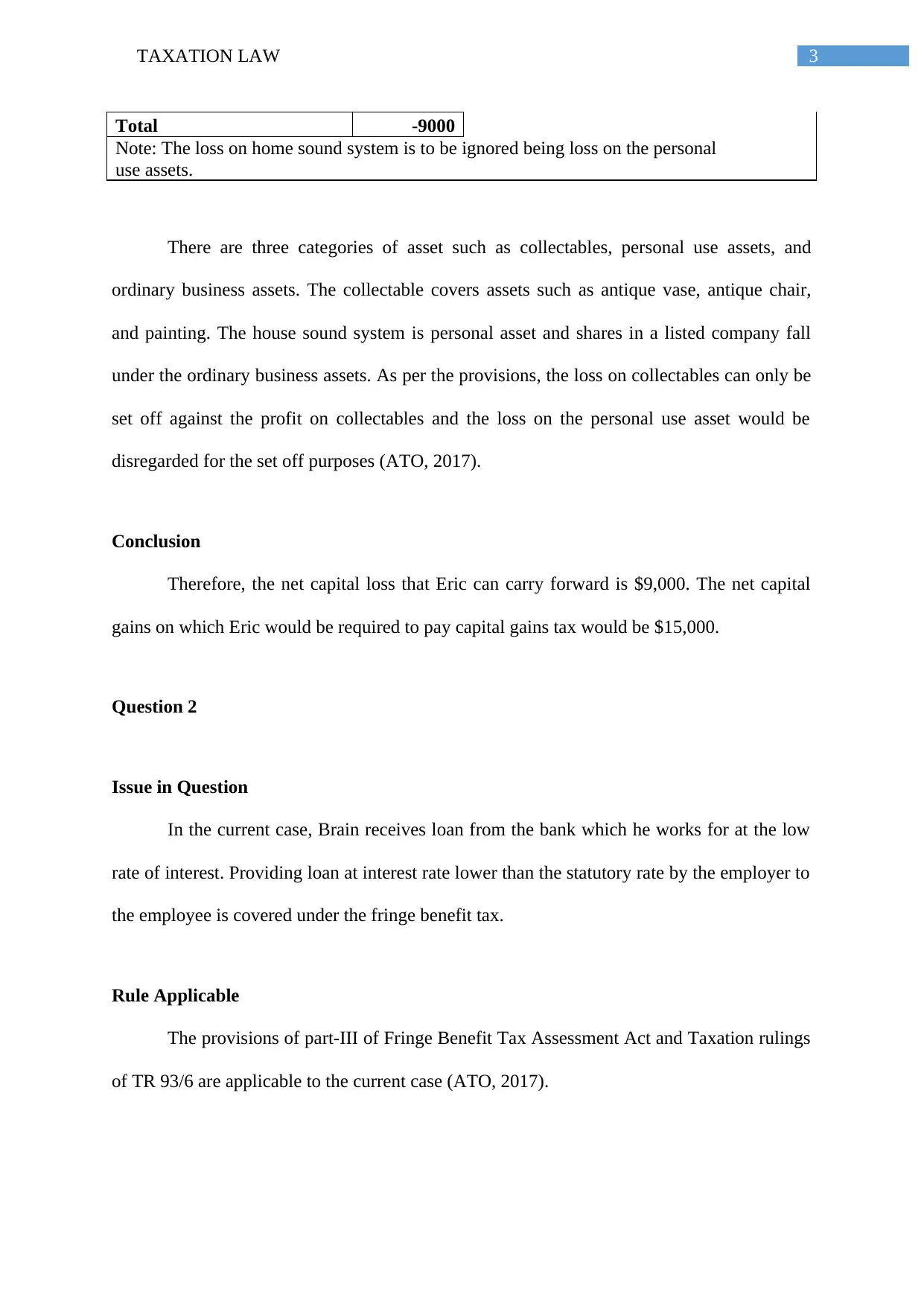
3TAXATION LAW
Total -9000
Note: The loss on home sound system is to be ignored being loss on the personal
use assets.
There are three categories of asset such as collectables, personal use assets, and
ordinary business assets. The collectable covers assets such as antique vase, antique chair,
and painting. The house sound system is personal asset and shares in a listed company fall
under the ordinary business assets. As per the provisions, the loss on collectables can only be
set off against the profit on collectables and the loss on the personal use asset would be
disregarded for the set off purposes (ATO, 2017).
Conclusion
Therefore, the net capital loss that Eric can carry forward is $9,000. The net capital
gains on which Eric would be required to pay capital gains tax would be $15,000.
Question 2
Issue in Question
In the current case, Brain receives loan from the bank which he works for at the low
rate of interest. Providing loan at interest rate lower than the statutory rate by the employer to
the employee is covered under the fringe benefit tax.
Rule Applicable
The provisions of part-III of Fringe Benefit Tax Assessment Act and Taxation rulings
of TR 93/6 are applicable to the current case (ATO, 2017).
Total -9000
Note: The loss on home sound system is to be ignored being loss on the personal
use assets.
There are three categories of asset such as collectables, personal use assets, and
ordinary business assets. The collectable covers assets such as antique vase, antique chair,
and painting. The house sound system is personal asset and shares in a listed company fall
under the ordinary business assets. As per the provisions, the loss on collectables can only be
set off against the profit on collectables and the loss on the personal use asset would be
disregarded for the set off purposes (ATO, 2017).
Conclusion
Therefore, the net capital loss that Eric can carry forward is $9,000. The net capital
gains on which Eric would be required to pay capital gains tax would be $15,000.
Question 2
Issue in Question
In the current case, Brain receives loan from the bank which he works for at the low
rate of interest. Providing loan at interest rate lower than the statutory rate by the employer to
the employee is covered under the fringe benefit tax.
Rule Applicable
The provisions of part-III of Fringe Benefit Tax Assessment Act and Taxation rulings
of TR 93/6 are applicable to the current case (ATO, 2017).
Paraphrase This Document
Need a fresh take? Get an instant paraphrase of this document with our AI Paraphraser
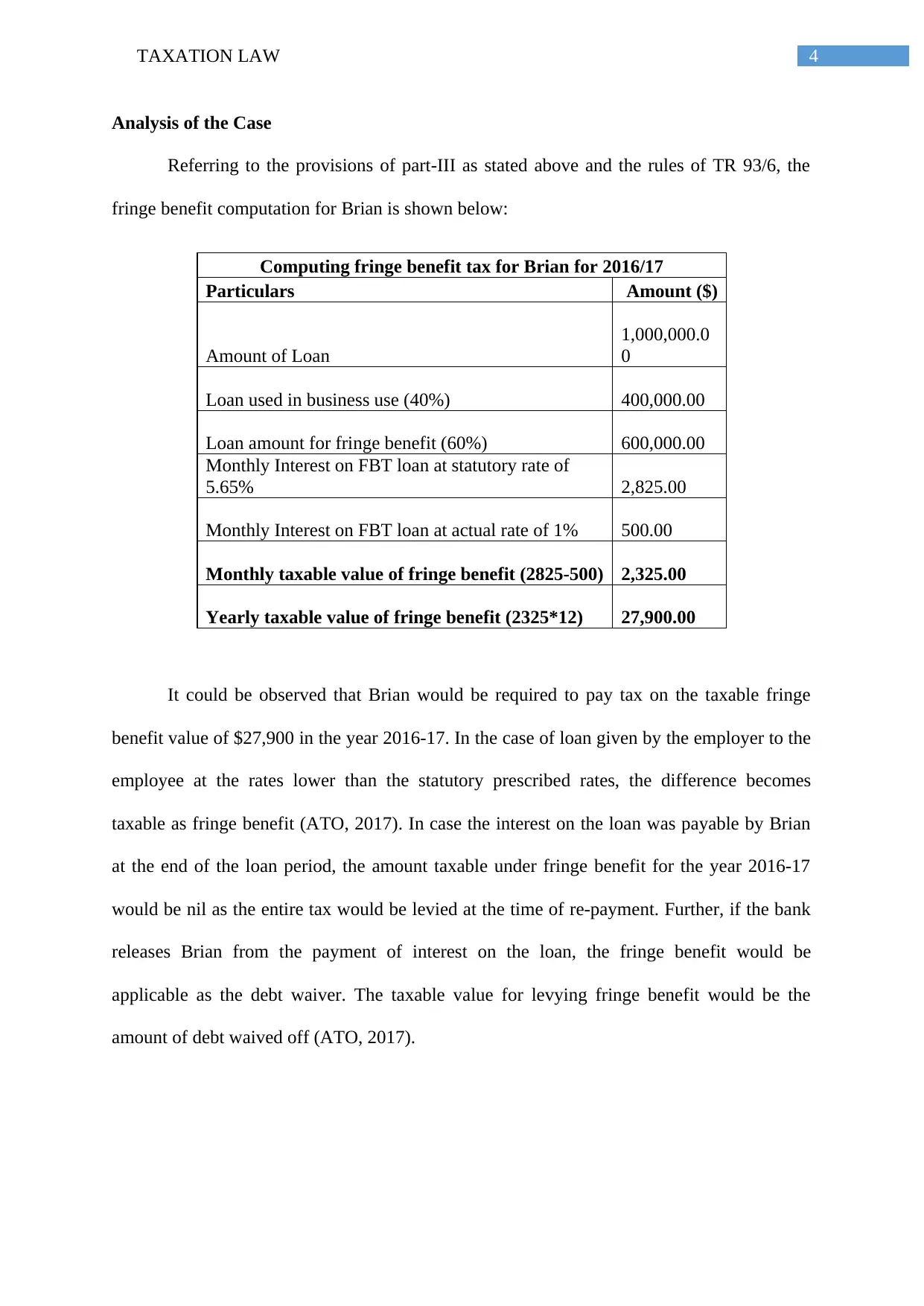
4TAXATION LAW
Analysis of the Case
Referring to the provisions of part-III as stated above and the rules of TR 93/6, the
fringe benefit computation for Brian is shown below:
Computing fringe benefit tax for Brian for 2016/17
Particulars Amount ($)
Amount of Loan
1,000,000.0
0
Loan used in business use (40%) 400,000.00
Loan amount for fringe benefit (60%) 600,000.00
Monthly Interest on FBT loan at statutory rate of
5.65% 2,825.00
Monthly Interest on FBT loan at actual rate of 1% 500.00
Monthly taxable value of fringe benefit (2825-500) 2,325.00
Yearly taxable value of fringe benefit (2325*12) 27,900.00
It could be observed that Brian would be required to pay tax on the taxable fringe
benefit value of $27,900 in the year 2016-17. In the case of loan given by the employer to the
employee at the rates lower than the statutory prescribed rates, the difference becomes
taxable as fringe benefit (ATO, 2017). In case the interest on the loan was payable by Brian
at the end of the loan period, the amount taxable under fringe benefit for the year 2016-17
would be nil as the entire tax would be levied at the time of re-payment. Further, if the bank
releases Brian from the payment of interest on the loan, the fringe benefit would be
applicable as the debt waiver. The taxable value for levying fringe benefit would be the
amount of debt waived off (ATO, 2017).
Analysis of the Case
Referring to the provisions of part-III as stated above and the rules of TR 93/6, the
fringe benefit computation for Brian is shown below:
Computing fringe benefit tax for Brian for 2016/17
Particulars Amount ($)
Amount of Loan
1,000,000.0
0
Loan used in business use (40%) 400,000.00
Loan amount for fringe benefit (60%) 600,000.00
Monthly Interest on FBT loan at statutory rate of
5.65% 2,825.00
Monthly Interest on FBT loan at actual rate of 1% 500.00
Monthly taxable value of fringe benefit (2825-500) 2,325.00
Yearly taxable value of fringe benefit (2325*12) 27,900.00
It could be observed that Brian would be required to pay tax on the taxable fringe
benefit value of $27,900 in the year 2016-17. In the case of loan given by the employer to the
employee at the rates lower than the statutory prescribed rates, the difference becomes
taxable as fringe benefit (ATO, 2017). In case the interest on the loan was payable by Brian
at the end of the loan period, the amount taxable under fringe benefit for the year 2016-17
would be nil as the entire tax would be levied at the time of re-payment. Further, if the bank
releases Brian from the payment of interest on the loan, the fringe benefit would be
applicable as the debt waiver. The taxable value for levying fringe benefit would be the
amount of debt waived off (ATO, 2017).
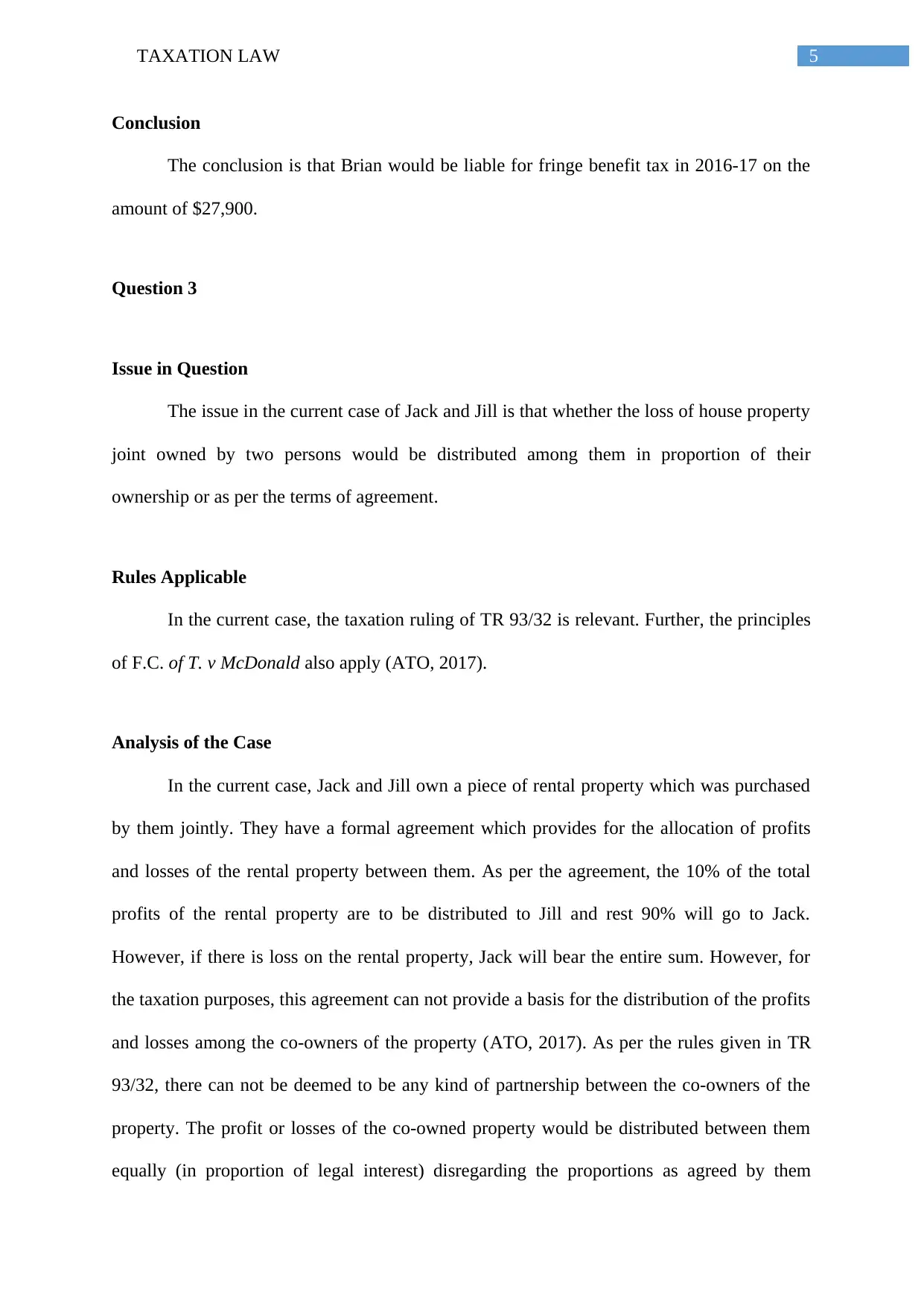
5TAXATION LAW
Conclusion
The conclusion is that Brian would be liable for fringe benefit tax in 2016-17 on the
amount of $27,900.
Question 3
Issue in Question
The issue in the current case of Jack and Jill is that whether the loss of house property
joint owned by two persons would be distributed among them in proportion of their
ownership or as per the terms of agreement.
Rules Applicable
In the current case, the taxation ruling of TR 93/32 is relevant. Further, the principles
of F.C. of T. v McDonald also apply (ATO, 2017).
Analysis of the Case
In the current case, Jack and Jill own a piece of rental property which was purchased
by them jointly. They have a formal agreement which provides for the allocation of profits
and losses of the rental property between them. As per the agreement, the 10% of the total
profits of the rental property are to be distributed to Jill and rest 90% will go to Jack.
However, if there is loss on the rental property, Jack will bear the entire sum. However, for
the taxation purposes, this agreement can not provide a basis for the distribution of the profits
and losses among the co-owners of the property (ATO, 2017). As per the rules given in TR
93/32, there can not be deemed to be any kind of partnership between the co-owners of the
property. The profit or losses of the co-owned property would be distributed between them
equally (in proportion of legal interest) disregarding the proportions as agreed by them
Conclusion
The conclusion is that Brian would be liable for fringe benefit tax in 2016-17 on the
amount of $27,900.
Question 3
Issue in Question
The issue in the current case of Jack and Jill is that whether the loss of house property
joint owned by two persons would be distributed among them in proportion of their
ownership or as per the terms of agreement.
Rules Applicable
In the current case, the taxation ruling of TR 93/32 is relevant. Further, the principles
of F.C. of T. v McDonald also apply (ATO, 2017).
Analysis of the Case
In the current case, Jack and Jill own a piece of rental property which was purchased
by them jointly. They have a formal agreement which provides for the allocation of profits
and losses of the rental property between them. As per the agreement, the 10% of the total
profits of the rental property are to be distributed to Jill and rest 90% will go to Jack.
However, if there is loss on the rental property, Jack will bear the entire sum. However, for
the taxation purposes, this agreement can not provide a basis for the distribution of the profits
and losses among the co-owners of the property (ATO, 2017). As per the rules given in TR
93/32, there can not be deemed to be any kind of partnership between the co-owners of the
property. The profit or losses of the co-owned property would be distributed between them
equally (in proportion of legal interest) disregarding the proportions as agreed by them
⊘ This is a preview!⊘
Do you want full access?
Subscribe today to unlock all pages.

Trusted by 1+ million students worldwide
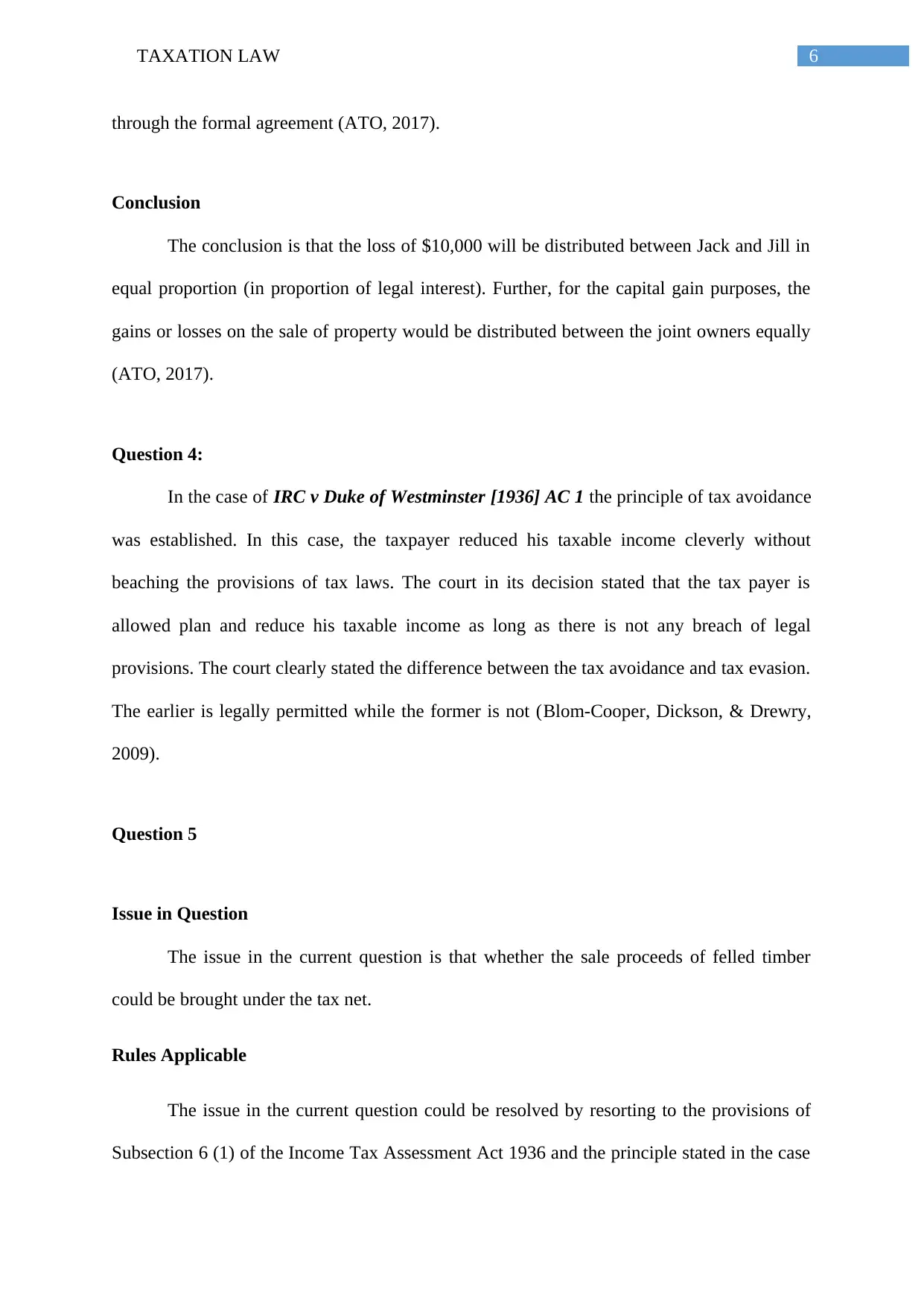
6TAXATION LAW
through the formal agreement (ATO, 2017).
Conclusion
The conclusion is that the loss of $10,000 will be distributed between Jack and Jill in
equal proportion (in proportion of legal interest). Further, for the capital gain purposes, the
gains or losses on the sale of property would be distributed between the joint owners equally
(ATO, 2017).
Question 4:
In the case of IRC v Duke of Westminster [1936] AC 1 the principle of tax avoidance
was established. In this case, the taxpayer reduced his taxable income cleverly without
beaching the provisions of tax laws. The court in its decision stated that the tax payer is
allowed plan and reduce his taxable income as long as there is not any breach of legal
provisions. The court clearly stated the difference between the tax avoidance and tax evasion.
The earlier is legally permitted while the former is not (Blom-Cooper, Dickson, & Drewry,
2009).
Question 5
Issue in Question
The issue in the current question is that whether the sale proceeds of felled timber
could be brought under the tax net.
Rules Applicable
The issue in the current question could be resolved by resorting to the provisions of
Subsection 6 (1) of the Income Tax Assessment Act 1936 and the principle stated in the case
through the formal agreement (ATO, 2017).
Conclusion
The conclusion is that the loss of $10,000 will be distributed between Jack and Jill in
equal proportion (in proportion of legal interest). Further, for the capital gain purposes, the
gains or losses on the sale of property would be distributed between the joint owners equally
(ATO, 2017).
Question 4:
In the case of IRC v Duke of Westminster [1936] AC 1 the principle of tax avoidance
was established. In this case, the taxpayer reduced his taxable income cleverly without
beaching the provisions of tax laws. The court in its decision stated that the tax payer is
allowed plan and reduce his taxable income as long as there is not any breach of legal
provisions. The court clearly stated the difference between the tax avoidance and tax evasion.
The earlier is legally permitted while the former is not (Blom-Cooper, Dickson, & Drewry,
2009).
Question 5
Issue in Question
The issue in the current question is that whether the sale proceeds of felled timber
could be brought under the tax net.
Rules Applicable
The issue in the current question could be resolved by resorting to the provisions of
Subsection 6 (1) of the Income Tax Assessment Act 1936 and the principle stated in the case
Paraphrase This Document
Need a fresh take? Get an instant paraphrase of this document with our AI Paraphraser
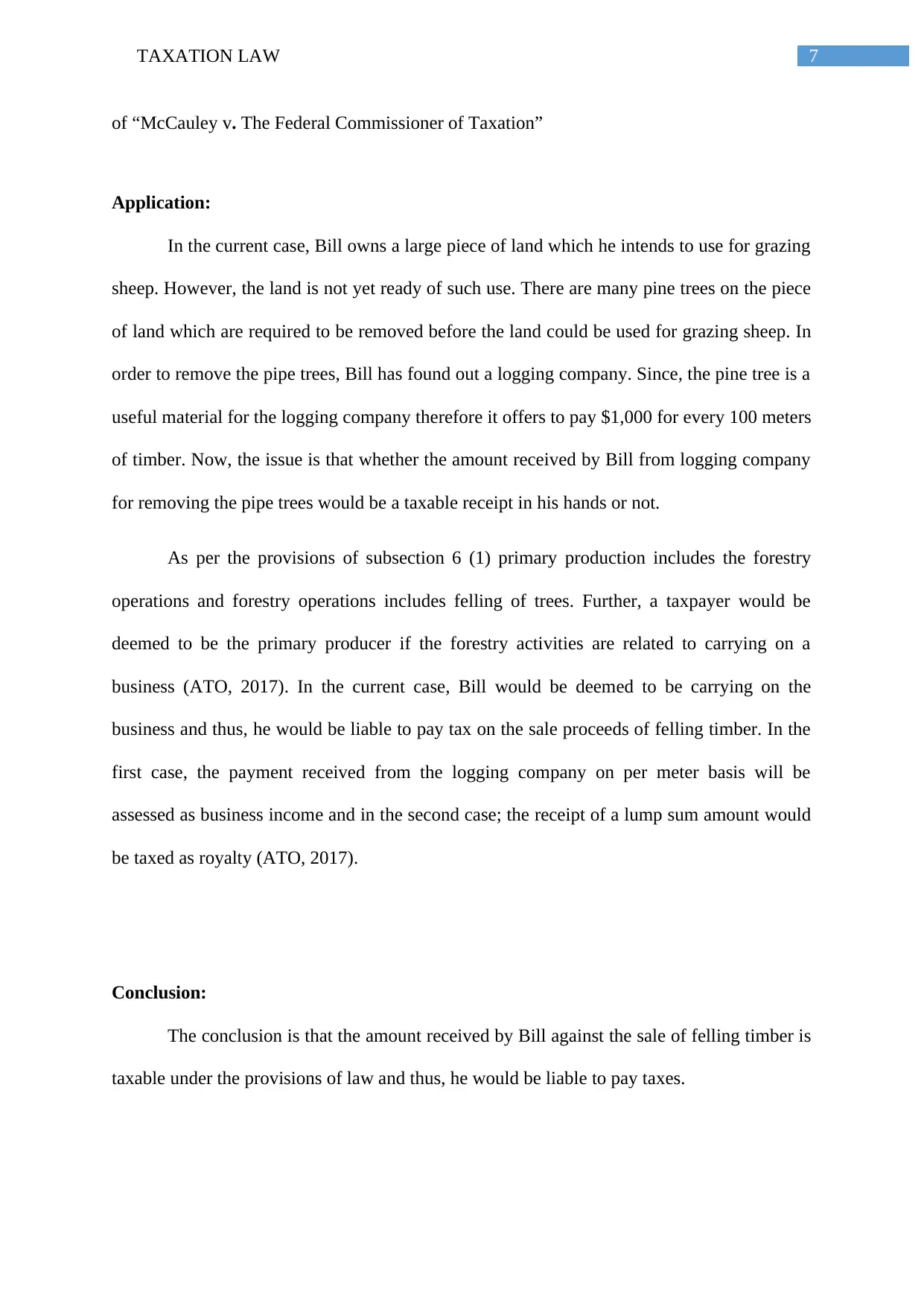
7TAXATION LAW
of “McCauley v. The Federal Commissioner of Taxation”
Application:
In the current case, Bill owns a large piece of land which he intends to use for grazing
sheep. However, the land is not yet ready of such use. There are many pine trees on the piece
of land which are required to be removed before the land could be used for grazing sheep. In
order to remove the pipe trees, Bill has found out a logging company. Since, the pine tree is a
useful material for the logging company therefore it offers to pay $1,000 for every 100 meters
of timber. Now, the issue is that whether the amount received by Bill from logging company
for removing the pipe trees would be a taxable receipt in his hands or not.
As per the provisions of subsection 6 (1) primary production includes the forestry
operations and forestry operations includes felling of trees. Further, a taxpayer would be
deemed to be the primary producer if the forestry activities are related to carrying on a
business (ATO, 2017). In the current case, Bill would be deemed to be carrying on the
business and thus, he would be liable to pay tax on the sale proceeds of felling timber. In the
first case, the payment received from the logging company on per meter basis will be
assessed as business income and in the second case; the receipt of a lump sum amount would
be taxed as royalty (ATO, 2017).
Conclusion:
The conclusion is that the amount received by Bill against the sale of felling timber is
taxable under the provisions of law and thus, he would be liable to pay taxes.
of “McCauley v. The Federal Commissioner of Taxation”
Application:
In the current case, Bill owns a large piece of land which he intends to use for grazing
sheep. However, the land is not yet ready of such use. There are many pine trees on the piece
of land which are required to be removed before the land could be used for grazing sheep. In
order to remove the pipe trees, Bill has found out a logging company. Since, the pine tree is a
useful material for the logging company therefore it offers to pay $1,000 for every 100 meters
of timber. Now, the issue is that whether the amount received by Bill from logging company
for removing the pipe trees would be a taxable receipt in his hands or not.
As per the provisions of subsection 6 (1) primary production includes the forestry
operations and forestry operations includes felling of trees. Further, a taxpayer would be
deemed to be the primary producer if the forestry activities are related to carrying on a
business (ATO, 2017). In the current case, Bill would be deemed to be carrying on the
business and thus, he would be liable to pay tax on the sale proceeds of felling timber. In the
first case, the payment received from the logging company on per meter basis will be
assessed as business income and in the second case; the receipt of a lump sum amount would
be taxed as royalty (ATO, 2017).
Conclusion:
The conclusion is that the amount received by Bill against the sale of felling timber is
taxable under the provisions of law and thus, he would be liable to pay taxes.
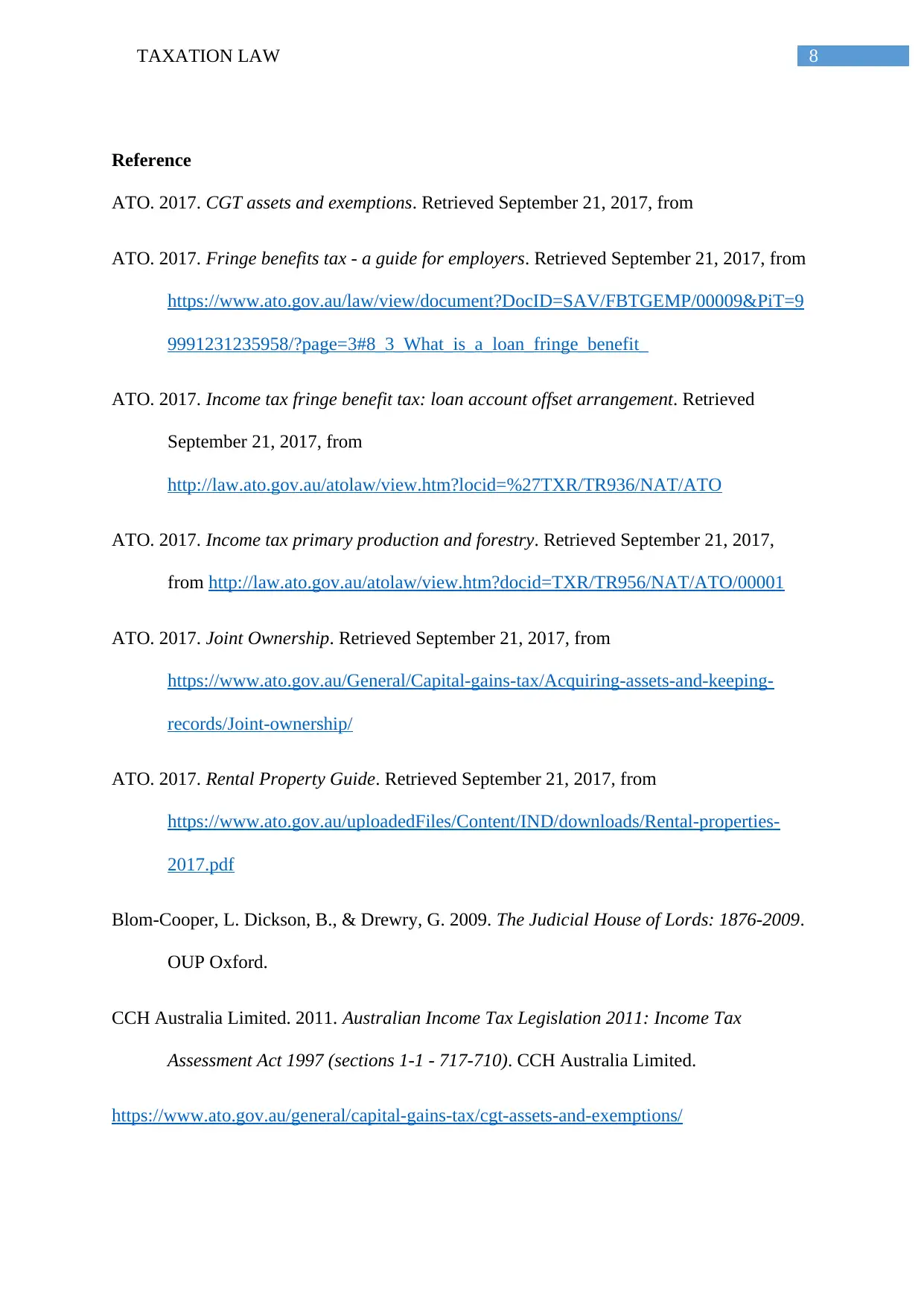
8TAXATION LAW
Reference
ATO. 2017. CGT assets and exemptions. Retrieved September 21, 2017, from
ATO. 2017. Fringe benefits tax - a guide for employers. Retrieved September 21, 2017, from
https://www.ato.gov.au/law/view/document?DocID=SAV/FBTGEMP/00009&PiT=9
9991231235958/?page=3#8_3_What_is_a_loan_fringe_benefit_
ATO. 2017. Income tax fringe benefit tax: loan account offset arrangement. Retrieved
September 21, 2017, from
http://law.ato.gov.au/atolaw/view.htm?locid=%27TXR/TR936/NAT/ATO
ATO. 2017. Income tax primary production and forestry. Retrieved September 21, 2017,
from http://law.ato.gov.au/atolaw/view.htm?docid=TXR/TR956/NAT/ATO/00001
ATO. 2017. Joint Ownership. Retrieved September 21, 2017, from
https://www.ato.gov.au/General/Capital-gains-tax/Acquiring-assets-and-keeping-
records/Joint-ownership/
ATO. 2017. Rental Property Guide. Retrieved September 21, 2017, from
https://www.ato.gov.au/uploadedFiles/Content/IND/downloads/Rental-properties-
2017.pdf
Blom-Cooper, L. Dickson, B., & Drewry, G. 2009. The Judicial House of Lords: 1876-2009.
OUP Oxford.
CCH Australia Limited. 2011. Australian Income Tax Legislation 2011: Income Tax
Assessment Act 1997 (sections 1-1 - 717-710). CCH Australia Limited.
https://www.ato.gov.au/general/capital-gains-tax/cgt-assets-and-exemptions/
Reference
ATO. 2017. CGT assets and exemptions. Retrieved September 21, 2017, from
ATO. 2017. Fringe benefits tax - a guide for employers. Retrieved September 21, 2017, from
https://www.ato.gov.au/law/view/document?DocID=SAV/FBTGEMP/00009&PiT=9
9991231235958/?page=3#8_3_What_is_a_loan_fringe_benefit_
ATO. 2017. Income tax fringe benefit tax: loan account offset arrangement. Retrieved
September 21, 2017, from
http://law.ato.gov.au/atolaw/view.htm?locid=%27TXR/TR936/NAT/ATO
ATO. 2017. Income tax primary production and forestry. Retrieved September 21, 2017,
from http://law.ato.gov.au/atolaw/view.htm?docid=TXR/TR956/NAT/ATO/00001
ATO. 2017. Joint Ownership. Retrieved September 21, 2017, from
https://www.ato.gov.au/General/Capital-gains-tax/Acquiring-assets-and-keeping-
records/Joint-ownership/
ATO. 2017. Rental Property Guide. Retrieved September 21, 2017, from
https://www.ato.gov.au/uploadedFiles/Content/IND/downloads/Rental-properties-
2017.pdf
Blom-Cooper, L. Dickson, B., & Drewry, G. 2009. The Judicial House of Lords: 1876-2009.
OUP Oxford.
CCH Australia Limited. 2011. Australian Income Tax Legislation 2011: Income Tax
Assessment Act 1997 (sections 1-1 - 717-710). CCH Australia Limited.
https://www.ato.gov.au/general/capital-gains-tax/cgt-assets-and-exemptions/
⊘ This is a preview!⊘
Do you want full access?
Subscribe today to unlock all pages.

Trusted by 1+ million students worldwide
1 out of 9
Related Documents
Your All-in-One AI-Powered Toolkit for Academic Success.
+13062052269
info@desklib.com
Available 24*7 on WhatsApp / Email
![[object Object]](/_next/static/media/star-bottom.7253800d.svg)
Unlock your academic potential
Copyright © 2020–2025 A2Z Services. All Rights Reserved. Developed and managed by ZUCOL.





